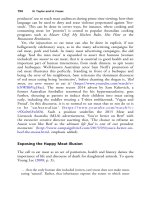The palgrave international handbook of a 466
Bạn đang xem bản rút gọn của tài liệu. Xem và tải ngay bản đầy đủ của tài liệu tại đây (39.19 KB, 1 trang )
468
R. Sollund
they relate personally to the other animal under their ownership (Sollund
2009). This is easier when the animal in question is not placed in a cage. A
caged animal—a bird, for example—becomes a ‘cage bird’, and the bird (and
the animal) are identified as a specific kind, through which the cage comes to
define the bird and prevent the owner from seeing who the bird is. The bird
and the cage, in other words, become one entity. An example of this is the
pionus parrot who has been ‘on display’ for 16 years in a garden center in
Oslo, as though he were just another plant adorning the space. This topic was
highlighted in a recent verdict from Borgarting lagmannsrett [A Norwegian
appeal court] (January 20, 2015) concerning trafficked and confiscated African
grey parrots killed by the authorities in which the judges argued that because
these birds were commonly held in cages as ‘cage birds’, they could not be
encompassed under the Norwegian Wildlife Law because they could not
survive in Norwegian nature. According to the court, in order for an animal
to be considered ‘wildlife’, he/she had to be born in Norway or, at least, be
capable of surviving in Norway without human intervention. Consequently,
rather than being ‘wild lives’ that had been trafficked,/and the offence thus
being breach of §47 of the Norwegian Wildlife law, they were considered
‘illegal goods’ that, according to the verdict from the first court instance in
this case, had to be confiscated in order to enforce the CITES convention. The
outcome for the birds was not only that they were confiscated to set an example,
but that they were killed as part of the regular procedure in Norway. So even
though CITES should protect endangered animals, the application of the
convention in court had the adverse effect, at least at individual level.
The main reason, however, why these trafficking victims are not seen in a
way that engenders compassion is ‘doxic speciesism’ (Sollund 2012), which
creates an effective barrier against seeing animals as our next of kin—as our
other. When the Norwegian authorities repeatedly and continuously kill
trafficking victims, they do so for practical reasons—they have nowhere to
put them—but also because these ‘animal others’ are objectified and not
valued and regarded as subjects with rights (Benton 1998).
Derridá (2002) criticizes those writers, including Lévinas, who have seen,
analyzed and reflected on the animal, but who have never been seen by an animal
(as he was seen naked by the cat): ‘They have taken no account of the fact that the
animal could look at them, and address them from down there from a wholly
other origin’ (p. 382). Derridá continues by saying that he and other philosophers have made of the animal a theorem, something seen (but not acknowledged) and not seeing (p. 383). In light of this, in order to see the other—the
animal who is a sentient being with interests (Regan 1983)—one must acknowledge that oneself is also seen—the animal will also look at the human—and









